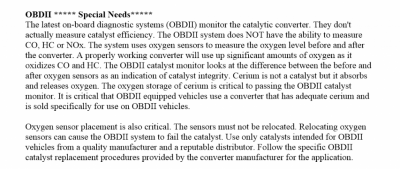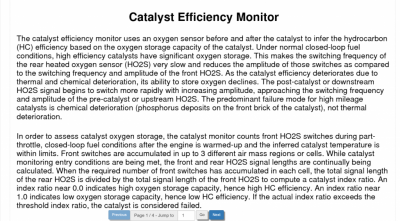Interesting reading here...………………...
As far as the Kooks Green Cats goes, the actual manufacturer of those cats, Global Emissions Systems Inc or GESI for short, says something different about their product. They say it is a Fed EPA certified 49 state legal hi HP cat (not CARB certified which would make it a 50 state legal cat). Watch these 2 YouTube videos, 1st is from Kooks the 2nd is from Vibrant, both use\provide the same GESI cats. Warning....gonna hear some marketing crosstalking going on between these 2 videos:
Now to switch gears to OBDII cat certification. The 1st item to understand is that an OBDII certified vehicle (like our S197's) do not measure cats for actual emissions output levels....they're measured for O2 storage\usage during oxidation w\ the premise that high O2 storage = high cat efficiency, low O2 storage = low cat efficiency as stated in this excert from a case study I found\read of catalytic converter operation & usage:
View attachment 72647
Now compare this w\ an excert from the Ford Workshop Manual describing how the OBDII cat efficiency coding works in these 05-10 S197's PCM:
View attachment 72648
This is why it's hard for most aftermarket cats to pass OBDII cat efficiency, they do not contain any cerium in the 1st catalyst brick to store the excess unburnt exhaust O2 (mostly have rhodium & palladium which are oxidizers that use O2 to break down HC & CO into CO2 & H2O--or in layman's terms burn the unburnt HC's up\force an extra O2 molecule to attach to the CO molecule to convert into CO2) so if there is excess O2 in the exhaust that can't be fully used up by the 2 cat substrate bricks it is picked up by the rear O2 sensor which will track w\ the front O2 sensor switching pattern enough to fail the cat efficiency switch ratio threshold number of .5-.6 for a min 92% efficiency thus set off the P0420\P0430 DTC's. The other reason that they have a hard time passing is due to most of them actually being too small (especially true when FI is used) as most are sized for the OEM equipped OEM tuned engine in NA configuration but are handicapped when the substrate cell size is increased to lower the flowing deltaP across them (reduces total effective treating substrate surface area).
They
can be made to work & pass OBDII legally but the tune will need to take all this into account to ensure that the cats aren't hit w\ more excess exhaust O2 than they can actually use up during oxidation (which means that any\all vacuum leaks need to be repaired...including the EVAP system's operational integrity, the tune needs to not under report MAF calc's--another way to say this is that both bank's LTFT's need to either read 0% or slightly -% when in CL--not read +% w\ both bank's STFT's switching around 0% & AFR is still set @ 14.64 in tune, no real plug misfires going on causing excess unburnt O2 in exhaust & OL WOT AFR needs to stay >12.5 as they can't handle anything lower than this....which is almost a given, especially for FI applications). This usually puts limits on the HP\TQ output of the engines in order to make them pass legally that most aren't gonna want, but some of this can be countered to a
certain extent by the choice of camshaft profiles used w\ the NA\FI engine (OL less than 42* advertised & if the cam EVC timings\VCT settings eliminate\limit EGR) or limiting the amount of boost used to not exceed 5-6 psi. The car WILL need to be equipped w\ the proper O2 sensor setup designed for the OBDII coding used in the PCM (a
dedicated pre-cat,
dedicated post-cat NB O2 sensor for 05-10 S197's, 11-14 S197's are different strategy due to using WB O2 sensors for front) & in good working order. This is important for the O2 sensor switching ratio to be as accurate as feasible as the 2 sensor types sample a different % of exhaust O2 volume due to the element shield size\porting differences. The front O2 sensor's switching rate & amplitude (time in ms the sine wave spends below the .450v line during each switch) is used by the PCM to calculate the amount of unburnt O2 volume in exhaust post combustion that is fed to the cats to use to promote oxidation of HC\CO present in exhaust.
To give a crude example of this OBDII process: the front O2 sensor for 1 cell needs to count 50 switches. For the switch ratio to be considered good the rear O2 switch count has to be at <25 switches w\ a shorter rise\fall pattern (amplitude) than the front O2 sensor to make a switch ratio threshold of .5. Another cell needs to see 70 front O2 sensor switches, the rear O2 sensor switch count needs to be <35 w\ a shorter switching amplitude to make the same threshold. The last cell needs to see 30 front O2 sensor switches, the rear O2 sensor switch count needs to be <15 w\ a shorter switching amplitude to make the same threshold. Then all avg'd out needs to come out <.5-.6 to pass OBDII cat efficiency as the .5 threshold equates to the min of 92% cat efficiency requirement of the 1.75 LEV Emissions std for the 05-10 S197 V8 cars as reported to the EPA by Ford at the time of manufacture. The lower the result from the switch ratio threshold the higher the cat's efficiency. The front O2 sensor's performance is just as important, if not more important, than the rear O2 sensor's performance for a cat to pass as well as the cat's own ability to use up all the unburnt O2 in the exhaust between the 2 O2 sensor positions while in CL operations.
So a perfectly good cat can fail an OBDII cert test in PCM if it is getting more O2 fed to it than it can use up...………………….. Thus the importance of cerium used in the 1st substrate brick...…& good proper maintenance along w\ a well fleshed out tune w\ cat operations in mind....not as an afterthought. See here:
View attachment 72649
Just trying to give some context to what is actually entailed for a cat to pass an OBDII cat certification test whether it is an OEM or aftermarket unit as programmed in these car's PCM. All a CEL eliminator is doing is attempting to artificially further reduce the exhaust O2 sample amount to the rear O2 sensor to slow it's switch rate\reduce it's amplitude further vs the front O2 sensor's switch rate\amplitude to get the cat switch ratio <.5-.6 threshold limit so the cat will pass OBDII in the PCM.....thus pass emissions. The flip side is that you can install an eliminator that is too large\too restrictive which can stall the rear O2 sensor from switching hardly at all causing a P0139\P0159 DTC (BxS2 O2 Sensor Slow to Respond) & these are illegal so keep this in mind if some do real visual compliance inspections.....which I'm sure most in here already know this.
Sorry for the long posting...……………………...








